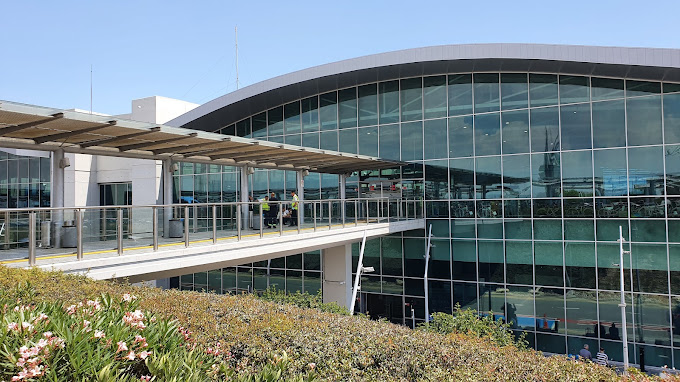Located just 4 kilometers southwest of the city of Larnaca, Larnaca International Airport is the largest aviation hub in Cyprus. It not only connects the island to the rest of the world but also plays a crucial role in developing tourism and the national economy. Serving both locals and millions of tourists annually, Larnaca Airport symbolizes hospitality and modern comfort on the sunny island.
Contents
- 1 History and Development: From Humble Beginnings to Modernity
- 2 Modern Infrastructure and Services: Designed for Passenger Comfort
- 3 Transportation: Getting to and from the Airport
- 4 Passenger Traffic and Destinations: A Window to the World
- 5 Future Prospects: A Vision for Growth
- 6 Environmental Responsibility
- 7 Safety and Comfort
- 8 Cultural Experience: A Glimpse of Cyprus
- 9 Social Responsibility
- 10 Travel Tips: Making Your Journey Enjoyable
History and Development: From Humble Beginnings to Modernity
The history of Larnaca Airport began during a challenging period for Cyprus. After the island’s division in 1974 and the closure of Nicosia Airport, a new international aviation center became necessary. On February 8, 1975, Larnaca Airport officially opened its doors, initially offering limited infrastructure and capabilities.
Despite its modest start, the airport quickly evolved. Over the following decades, significant modernization and expansion projects were undertaken. A milestone was reached in 2009 with the inauguration of a new passenger terminal. This state-of-the-art facility can handle up to 7.5 million passengers annually, significantly enhancing capacity and service quality.

Modern Infrastructure and Services: Designed for Passenger Comfort
Larnaca Airport is now a cutting-edge transportation hub equipped with the latest technology. The terminal is divided into two levels:
- Upper Level: Dedicated to departing passengers, featuring check-in zones, security checkpoints, and boarding gates.
- Lower Level: Serves arriving passengers, with baggage claim areas, customs, and immigration control.
To enhance travelers’ convenience, the airport offers a wide range of services:
- Duty-Free Shops: A broad selection of goods, including perfumes, alcohol, tobacco, and souvenirs, at competitive prices.
- Souvenir Stores: Unique Cypriot handmade items, traditional sweets, and other memorabilia are available.
- Cafés and Restaurants: Options range from quick snacks to full meals featuring local and international cuisines.
- Financial Services: Currency exchange offices and ATMs are conveniently located for quick transactions.
- Connectivity and Internet: Free Wi-Fi is available throughout the terminal, along with charging stations for mobile devices.
- Car Rentals: Both international and local rental companies offer a wide selection of vehicles.
- Baggage Wrapping and Storage: Services include protective wrapping for luggage and storage facilities.
- Accessibility Services: Specially trained staff and adapted infrastructure ensure comfortable navigation for passengers with limited mobility.
Transportation: Getting to and from the Airport
Thanks to its strategic location, Larnaca Airport is well-connected to major cities and resorts across Cyprus. Travelers have several transportation options:
Buses
- Local Routes: Buses №417, 425, and 429 connect the airport to central Larnaca, with tickets costing around €1.50.
- Intercity Express: Comfortable buses link the airport to cities like Nicosia and Limassol, with ticket prices around €9 and travel times ranging from 45 minutes to 1.5 hours.
Taxis
- Taxi stands are located directly outside the terminal and operate 24/7.
- Fares: Larnaca city center (€15-20), Limassol (€60-70), Nicosia (€50). It’s advisable to confirm the fare in advance.
Car Rentals
- Major brands such as Hertz, Avis, and Europcar, alongside local companies, offer rentals.
- Requirements: An international driver’s license and a credit card are necessary to rent a car.
- Benefits: Renting a car allows flexibility to explore remote attractions.

Passenger Traffic and Destinations: A Window to the World
Larnaca Airport serves as a major international hub, with flights operated by over 50 airlines connecting Cyprus to 150 cities in 38 countries. Key destinations include:
- United Kingdom: London, Manchester, Birmingham
- Greece: Athens, Thessaloniki, Crete
- Israel: Tel Aviv
- Poland: Warsaw, Krakow
- Germany: Frankfurt, Munich, Berlin
Record figures
In January 2023, the airport handled 471,001 passengers, setting a record for the month. This growth highlights Cyprus’s rising popularity as a tourist destination and the airport’s operational efficiency.
Future Prospects: A Vision for Growth
The management of Larnaca Airport is continuously striving to improve infrastructure and services. Key development areas include:
- Terminal Expansion:Increasing passenger areas and opening new commercial zones.
- Technological Upgrades: Introducing automated check-in and security systems for faster and more convenient processes.
- Sustainability Initiatives: Emphasizing eco-friendly measures like reducing emissions, energy conservation, and waste management.
- Staff Training: Investing in employee development to maintain high standards of service and safety.

Environmental Responsibility
In today’s world, environmental concerns are more relevant than ever, and Larnaca Airport is committed to sustainable development. Measures include:
- Energy Efficiency: Using energy-saving equipment and lighting, as well as installing solar panels for renewable energy generation.
- Waste Management: Implementing recycling systems and reducing plastic usage.
- Water Conservation: Utilizing water recycling systems and low-consumption sanitary technologies.
- Green Areas: Creating landscaped zones around the airport to improve the environment and enhance the atmosphere.
Safety and Comfort
Passenger and staff safety is a top priority, ensured through:
- Modern Monitoring Systems: Advanced technologies for screening and surveillance.
- Staff Training: Regular certifications and training programs for professionalism.
- COVID-19 Protocols: Enhanced sanitation measures, including disinfection of spaces and equipment.
Cultural Experience: A Glimpse of Cyprus
Larnaca Airport is more than a transportation hub—it also reflects the culture and traditions of Cyprus:
- Art Exhibitions: The terminal hosts displays by local artists and photographers.
- Musical Performances: Folk music events are organized during holidays.
- Culinary Delights: Restaurants offer Cypriot dishes, giving travelers a taste of local cuisine.

Social Responsibility
The airport actively participates in initiatives that benefit the local community:
- Educational Programs: Organizing tours and educational activities for students.
- Charity Support: Collaborating with local charities and participating in social campaigns.
- Job Creation: As a major employer, the airport provides jobs for many residents in the region.
Travel Tips: Making Your Journey Enjoyable
- Online Check-In: Many airlines offer online check-in to save time.
- Arrive Early: For international flights, arrive 2-3 hours before departure to avoid last-minute stress.
- Baggage Rules: Familiarize yourself with airline baggage policies to avoid extra fees and delays.
- VIP Services: Consider using business lounges for added comfort while waiting for your flight.

Larnaca International Airport plays a vital role in Cyprus’s connectivity, tourism, and economy. Its modern infrastructure, wide range of services, and attention to detail make traveling through this airport a pleasant and comfortable experience.
Thanks to ongoing developments and innovations, Larnaca Airport continues to raise service standards, remaining a leader in the region. Whether you are a resident of Cyprus or a visitor to the island, Larnaca Airport welcomes you with warmth and care, embodying the true spirit of Cypriot hospitality.
















